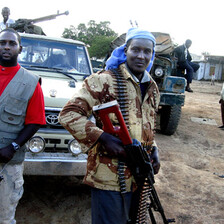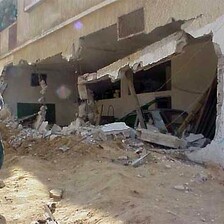The Electronic Intifada 7 December 2004

Israeli TV Tackles War for Hearts and Minds, described Israels new reality show, The Ambassador, in which multi-lingual Israeli youths are flown around the world. (EI Image: AEF)
The scene was all too familiar to a country imbued with Schindler’s List, The Piano and multi-million dollar monuments declaring, “Never again”: A young Palestinian violinist ridiculed at an army checkpoint, forced to “play something sad.”
Not surprisingly, the handful of Jews who witnessed this first hand were reminded of Majdanek, one of the Nazi extermination camps where Jewish musicians were forced to play something sad as their brethren walked into death. But since it was Thanksgiving and the violinist was named Wissam Tayem, the New York Times’ Greg Myre placed the scene discretely in the last paragraph of an article on Arafat’s possible successor. Like mother saying, “Pass the gravy.”
Three days earlier, Myre won my personal objectivity award for reporting the murder of 13-year-old Iman al-Hams—the 529th Palestinian child killed by Israel’s army since 2000, according to Israeli sources—with complete sentimental detachment. Although al-Hams’ killer, who shot her 15 times at “point blank” (according to The Jerusalem Post), told Israeli military prosecutors that he would have killed her if she were three (according to The Guardian), Myre couched the indictment as an allegation. So stoic was Myre that he chose not to report the killer’s admission that the girl posed no apparent threat before he initially took aim.
Turn back even further to Israel’s “Days of Penitence” operation that killed over 130 Palestinians in October. Then, the New York Times afforded skimpy, arguably misleading, coverage of this war on civilians, while its leading stories focused on the political flak Sharon received for his unilateral—though not yet actual—plan to disengage from Gaza. For those who were conscious of the ongoing massacre, perhaps conscious enough to donate to the Palestine Children’s Welfare Fund, the Times’ Web site left a special reminder: Steven Erlanger’s gratuitous video clip of the September 1 suicide bombing in Beersheba.
(Note to over-educated Kerry-liberals: Last October, when you asked your Palestine-sympathetic friends what they thought of Sharon’s political situation and they looked at you like you were laughing at a funeral, this was why.)
Why then can’t the Times acknowledge the symbolic value Wissam Tayem or Imam al-Hams? Would it somehow cheapen the historical scale of the Holocaust to draw parallels between its perpetrators and its victims’ descendents? Was the Holocaust not the sum of many terrible elements, several of which Israel has already employed against Palestinians? What about the Times’ readers, who are taxed some $5 billion annually to uphold Israel’s colonial occupation?
These questions came to mind last week when I read Myre’s latest attempt to save Israel from itself. The article, titled, “Israeli TV Tackles War for Hearts and Minds,” described Israel’s new “reality” show, The Ambassador, in which multi-lingual Israeli youths are flown around the world — I actually don’t want to know how my tax dollars figure into this — vying for bragging rights in the army’s, I mean, the country’s propaganda campaign. The show’s most recent loser, Ofra Bin Nun, took her exit after trying to “make it clear that Israel has not taken anything from anyone” (her words).
But there is an element that makes Myre’s story simultaneously fitting and misplaced, outrageous and practical, idiotic and genius: He writes about a reality show while ignoring reality altogether.
Myre opens with the statement, “For many Israelis, it is received wisdom that their country is misunderstood by the world, and that its official representatives compound the problem through inept diplomacy.” Interesting. Although I monitor Middle Eastern news more regularly than I floss, I somehow missed that time when Sharon punched the Queen of England in the face. Or that UN summit where Netanyahu was caught peeing on the ice sculpture of Nelson Mandela.
To illustrate what he means, Myre quotes Joey Low, a New York businessman and promoter of The Ambassador. Low tells Myre that the show might serve a useful purpose, “because Israelis don’t always know how they are being perceived abroad.”
And how is Israel being perceived in the U.S.? In the six months between January and June, 2001 Fairness and Accuracy in Reporting conducted a study showing National Public Radio’s (NPR) coverage trends of the “Israeli/Palestinian conflict.” Though often credited as the U.S.’s leading progressive broadcaster, NPR reported 81 percent of Israeli deaths during that period, while acknowledging only 34 percent of Palestinian deaths.
Similarly, Alison Weir’s research of the San Francisco Chronicle showed that between September 2000 and March 2001, the newspaper reported 150 percent of Israeli children’s deaths (sometimes covering the same incident more than once), and only five percent of Palestinian children killed. The figures seem even more baffling when one considers the actual number of Israeli to Palestinian children killed: four to 93.
But the PR MyreWire is too busy selling an image to consider journalistic scrutiny, or even a token Palestinian viewpoint. Myre instead pursues a formula described best by Israel’s acclaimed spin doctor, Abba Eban: “Propaganda is the art of persuading others of what you do not necessarily believe yourself.”
One example is Myre’s paragraph about The Ambassador’s judge, Nachman Shai, who is a former Israeli military spokesperson — a burning bush of irony that Myre somehow misses. While describing Shai’s background, Myre mentions the 1967 war as one of the instances in which Israel faced “actual or imminent attack.”

Candidates of the Israeli “reality” show The Ambassador.
Meanwhile, Myre ignores a rather glaring historical record, most notably, Israel’s admission that it struck preemptively in 1967. Or war architect Ezer Weizman’s claim that Israel faced “no threat of destruction” in June 1967, and that “the threat of destruction was already removed from Israel during the [1948] War of Independence” — the last three words are, for the record, forever and ever, not mine.
There is a scene in the cult classic “Animal House,” where John Belushi’s character, in a heated pep talk, says, “What did we do when the Germans bombed Pearl Harbor?” to which his fraternity brother comments, “Don’t stop him, he’s rolling.” So Myre ushers us into the following sentence: “But now [Israel] is often portrayed as the aggressor in the fighting with the Palestinians,” and with a territorial middle finger to The Guardian — why not? — Myre adds, “particularly in the European news media.”
Myre’s work is not done, of course, without a Biblical reference to all at once invoke his readers’ Catholic guilt, Jewish discipline and Protestant hysteria. “The David and Goliath roles have been reversed, and it’s more difficult to explain what we’re doing today,” Shai tells us.
Well soldier, if Israel is losing, then please remind us who is winning.
Zachary Wales is a journalist, media analyst and graduate student of international public policy at Columbia University. He is a co-founder of Labor for Palestine, and a member of the New York Chapter of Al-Awda, the Palestinian Right of Return Coalition.
Related Links





